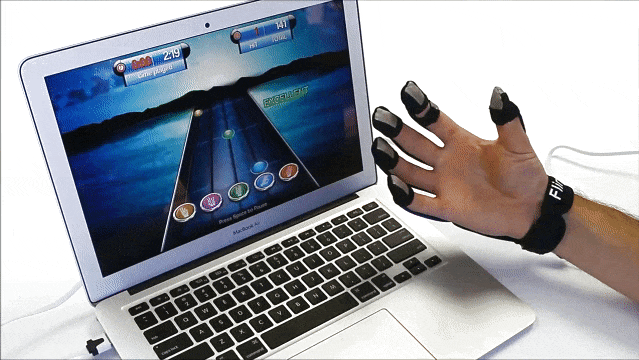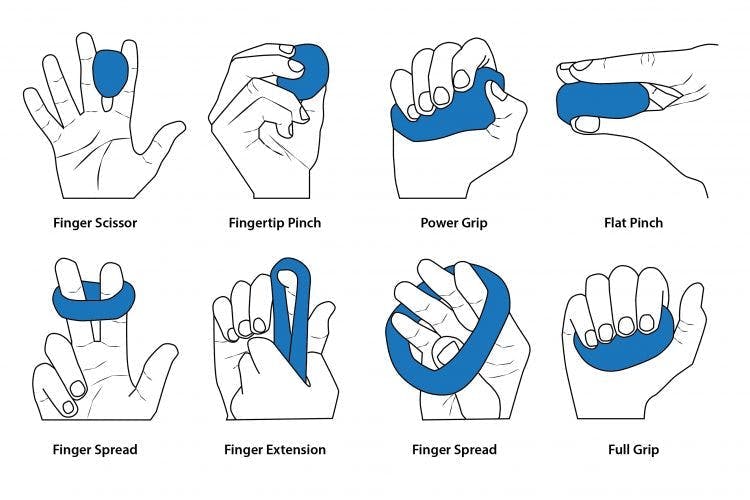A stroke can affect many functions, including the ability to grasp and release objects with the hand. Practicing grasp and release activities after stroke can help develop fine motor skills, which are often among the last functions to return after stroke.
Regaining effective hand function is essential for performing activities of daily living, such as grooming and feeding oneself. Repetitively practicing exercises and activities that involve using affected hand functions can help stroke survivors recover by stimulating neuroplasticity, or adaptive brain rewiring.
To help with this, the following article includes some of the best grasp and release activities for stroke recovery. An outline of how a stroke can affect hand functions and how grasp and release activities can stimulate recovery is also included. Please use the links below to jump directly to any section of this article.
- Potential hand function changes after stroke
- Grasp and release activities for stroke recovery
- How can grasp and release activities promote recovery?
How Can a Stroke Affect Hand Functions?
A stroke occurs when the blood supply to the brain becomes disrupted, depriving affected areas of the brain of oxygen and other essential nutrients. This results in damage to the brain, which in turn may impact functions controlled by the areas of the brain that have been affected.
When a stroke occurs in an area of the brain responsible for hand functions, such as the primary motor cortex or basal ganglia, individuals may have difficulties using their hands effectively. Stroke survivors often experience deficits in only one hand rather than both, typically on the side opposite of where the stroke occurred. This is because each side of the brain controls motor functions primarily on the opposite side of the body.
There are various secondary conditions of stroke that may affect the ability to use the hands effectively, including hemiplegia, tremors, and ataxia. These conditions, among others, may affect a number of hand functions, including:
- Hand strength
- Sensation
- Fine motor coordination
- Precision
- Isolated finger movements and thumb opposition
- In-hand manipulation
- Grasp and release functions
Depending on which hand functions are most impacted, the best exercises and activities for recovery may vary. However, the following list of grasp and release activities for stroke recovery is a great starting point. For more individualized recommendations for recovering hand functions, consider asking for a referral to an occupational therapist.
The Best Grasp and Release Activities for Stroke Recovery
Just as each stroke is unique, each individual also experiences different effects of stroke and severity of impairment. The following list of grasp and release activities for stroke has been loosely arranged as a progression from simple activities to more challenging activities. As hand functions begin to improve, practicing the more advanced activities on this list can promote continued improvements.
While these are all excellent activities, survivors should focus on practicing tasks that are difficult but not impossible to complete to boost recovery. One way to find this “just-right challenge” is to start at the beginning of this list and gradually progress until the activities seem appropriately difficult. Options to modify the difficulty of each activity are also included to allow survivors to find the best exercises for their specific skill level.
With that in mind, here are some of the best grasp and release activities for stroke recovery:
1. Grasping Cups
Practicing grasping and releasing cups is an excellent way for those with limited hand mobility after stroke to improve their grasp. Since a cup is a relatively large, light-weight object, this activity is a good starting point for recovering the ability to grasp objects.
Larger cups tend to be easier to grasp than smaller cups. For those seeking a challenge, consider moving cups or cans of food from the counter into an overhead cupboard.
2. Towel Walks
Place an open hand at the bottom of an unfolded towel lying on the table. Then, slowly begin squeezing the fingers to maneuver the majority of the towel into the hand. Release the towel by extending the fingers, pushing it back into a flattened position.
This activity can be completed with the fingers moving simultaneously, similar to making a fist. Alternatively, those looking to increase the difficulty can work on “walking” their fingers up the towel, moving one finger at a time.
3. Picking Up Items with Tongs
Lay out an assortment of items of different sizes and textures. Then, try to pick up each item with a pair of tongs and arrange them in a row from smallest to biggest. The spring in the tongs provides some resistance, strengthening muscles of the fingers and hand. Additionally, this activity helps develop hand-eye coordination.
If picking up smaller items is difficult, focus on picking up larger items initially, as these tend to be easier. Survivors seeking a challenge can use clothespins to pick up small items, such as cotton balls, alternating which fingers are used in conjunction with the thumb for pinching.
4. MusicGlove Hand Therapy

MusicGlove combines hand therapy, music, and gaming together for the ultimate hand rehabilitation experience. This device encourages survivors to engage with music by rhythmically pinching the fingers together when prompted by specific cues on the screen. According to the research, users of the MusicGlove demonstrate “a significantly greater improvement in hand grasping ability” than those pursuing only conventional therapy.
MusicGlove has multiple difficulty levels so that individuals are challenged at all stages of recovery, and it can also track one’s progress. Through each 30-minute session, stroke survivors can perform hundreds of finger-gripping movements, stimulating recovery.
5. Sorting Candy
Find a bag of a colorful candy (like Starbursts, Skittles or M&Ms). Pick up each piece of candy to sort them by color or arrange them in a pattern. This can improve both fine motor skills and cognitive abilities.
Larger pieces of candy, like peach rings or tootsie-pops, will be easier to grab. Therefore, survivors should consider starting off these types of candies, transitioning down to smaller pieces of candy as their grasping skills improve.
For an even further challenge, rather than picking up each candy individually, consider taking a small handful of candies in the hand. Then manipulate them one by one to the thumb and index finger to set down.
6. Alphabet Magnets
Get a set of alphabet magnets and practice spelling out words and creating sentences on the refrigerator. The attraction between the magnet and the refrigerator surface forces survivors to grip it more strongly when pulling it off. This activity can also help develop hand-eye coordination through practicing accurate spacing and placement of the letters.
If alphabet magnets are too challenging to grasp, consider using magnetic chip clips. For an added balance challenge, practice placing the magnets as low as possible.
7. Stringing Beads
Unlike the other activities, stringing beads requires both hands to work together, a skill referred to as bilateral coordination. Using the affected hand, pick up one bead at a time to place it on a string or pipe cleaner. Pull the bead to the end of the string, using both hands to ensure it gets all the way on.
If picking up tiny objects is still difficult, start with larger beads and then progress to smaller ones. To challenge one’s cognitive skills in addition to fine motor abilities, consider using a pattern when adding the beads to the string.
8. Therapy Putty

Therapy putty is an extremely versatile hand therapy product. Survivors can mold it into any shape and squeeze it between the fingers or the entire hand. Some even choose to place small objects, such as pennies, into the putty. This encourages survivors to work through the putty both when hiding the objects within the putty and when removing them.
Therapy putty comes in a variety of different resistances to help survivors improve their grasping skills at any level of recovery. Be sure to keep therapy putty off of furniture and carpet, as it can be very hard to remove.
See more hand therapy putty exercises »
Each of these activities targets slightly different hand functions, in addition to simply addressing grasp and release skills. Working through the activities in this list daily, focusing on the activities most appropriate to the survivor’s skill level, is an excellent way to improve hand functions after stroke.
How Can Grasp and Release Activities Promote Recovery?
Although the hands may be affected by a stroke, the root cause of limited hand functions is really the damage to the brain incurred during the stroke. Therefore, it is essential to address this damage for an optimal recovery.
One of the best ways to do so is to promote neuroplasticity, or the brain’s ability to adapt and rewire itself. This allows healthy areas of the brain to assume control of functions regulated by areas of the brain damaged during the stroke.
Neuroplasticity is stimulated by frequent and consistent repetition of exercises and activities involving affected functions. Therefore, consistently practicing grasp and release activities for stroke recovery can help create and strengthen new and existing neural pathways in the brain, shifting control of grasp and release skills to healthy areas of the brain. This leads to an overall functional improvement in the ability to grasp and release.
The grasp and release activities for stroke recovery listed in this article were chosen as they are more engaging than rote exercises, thus may be practiced more frequently. Finding activities that are engaging and motivating can be difficult, but is an excellent way to encourage survivors to complete the repetitive tasks necessary to promote improvement.
Understanding Grasp and Release Activities for Stroke Recovery
Following a stroke, many survivors experience changes in hand functions. Although these functions are often among the last to be recovered, the ability to use the hand effectively is essential for many daily activities. Therefore, many survivors seek to find effective techniques to recover the ability to use their hand(s) functionally.
Practicing grasp and release activities for stroke recovery, such as the examples listed in this article, is an excellent way to recover hand functions. Consistent, repetitive practice can stimulate adaptive rewiring in the brain, leading to lasting functional changes.
Survivors with impaired hand functions should consider trying the grasp and release activities outlined above to promote improvements, even if their stroke was years ago. Consult with an occupational therapist for more individualized recommendations and to discover even more ways to improve hand functions after stroke.
The post Effective Grasp and Release Activities for Stroke Recovery appeared first on Flint Rehab.



